Related Research Articles
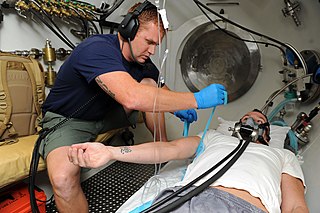
Decompression sickness is a medical condition caused by dissolved gases emerging from solution as bubbles inside the body tissues during decompression. DCS most commonly occurs during or soon after a decompression ascent from underwater diving, but can also result from other causes of depressurisation, such as emerging from a caisson, decompression from saturation, flying in an unpressurised aircraft at high altitude, and extravehicular activity from spacecraft. DCS and arterial gas embolism are collectively referred to as decompression illness.

A dive computer, personal decompression computer or decompression meter is a device used by an underwater diver to measure the elapsed time and depth during a dive and use this data to calculate and display an ascent profile which, according to the programmed decompression algorithm, will give a low risk of decompression sickness. A secondary function is to record the dive profile, warn the diver when certain events occur, and provide useful information about the environment.
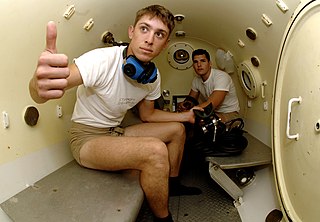
Diving medicine, also called undersea and hyperbaric medicine (UHB), is the diagnosis, treatment and prevention of conditions caused by humans entering the undersea environment. It includes the effects on the body of pressure on gases, the diagnosis and treatment of conditions caused by marine hazards and how relationships of a diver's fitness to dive affect a diver's safety. Diving medical practitioners are also expected to be competent in the examination of divers and potential divers to determine fitness to dive.
The Varying Permeability Model, Variable Permeability Model or VPM is an algorithm that is used to calculate the decompression stops needed for ambient pressure dive profiles using specified breathing gases. It was developed by D.E. Yount and others for use in professional diving and recreational diving. It was developed to model laboratory observations of bubble formation and growth in both inanimate and in vivo systems exposed to pressure. In 1986, this model was applied by researchers at the University of Hawaii to calculate diving decompression tables.
In diving and decompression, the oxygen window is the difference between the partial pressure of oxygen (PO2) in arterial blood and the PO2 in body tissues. It is caused by metabolic consumption of oxygen.
The Bühlmann decompression model is a neo-Haldanian model which uses Haldane's or Schreiner's formula for inert gas uptake, a linear expression for tolerated inert gas pressure coupled with a simple parameterised expression for alveolar inert gas pressure and expressions for combining Nitrogen and Helium parameters to model the way inert gases enter and leave the human body as the ambient pressure and inspired gas changes. Different parameter sets are used to create decompression tables and in personal dive computers to compute no-decompression limits and decompression schedules for dives in real-time, allowing divers to plan the depth and duration for dives and the required decompression stops.

Capt. Edward Deforest Thalmann, USN (ret.) was an American hyperbaric medicine specialist who was principally responsible for developing the current United States Navy dive tables for mixed-gas diving, which are based on his eponymous Thalmann Algorithm (VVAL18). At the time of his death, Thalmann was serving as assistant medical director of the Divers Alert Network (DAN) and an assistant clinical professor in anesthesiology at Duke University's Center for Hyperbaric Medicine and Environmental Physiology.
In physiology, isobaric counterdiffusion (ICD) is the diffusion of different gases into and out of tissues while under a constant ambient pressure, after a change of gas composition, and the physiological effects of this phenomenon. The term inert gas counterdiffusion is sometimes used as a synonym, but can also be applied to situations where the ambient pressure changes. It has relevance in mixed gas diving and anesthesiology.

Captain Albert Richard Behnke Jr. USN (ret.) was an American physician, who was principally responsible for developing the U.S. Naval Medical Research Institute. Behnke separated the symptoms of Arterial Gas Embolism (AGE) from those of decompression sickness and suggested the use of oxygen in recompression therapy.

Half time is the time taken by a quantity to reach one half of its extremal value, where the rate of change is proportional to the difference between the present value and the extremal value. It is synonymous with half-life, but used in slightly different contexts.

The decompression of a diver is the reduction in ambient pressure experienced during ascent from depth. It is also the process of elimination of dissolved inert gases from the diver's body which accumulate during ascent, largely during pauses in the ascent known as decompression stops, and after surfacing, until the gas concentrations reach equilibrium. Divers breathing gas at ambient pressure need to ascend at a rate determined by their exposure to pressure and the breathing gas in use. A diver who only breathes gas at atmospheric pressure when free-diving or snorkelling will not usually need to decompress. Divers using an atmospheric diving suit do not need to decompress as they are never exposed to high ambient pressure.

To prevent or minimize decompression sickness, divers must properly plan and monitor decompression. Divers follow a decompression model to safely allow the release of excess inert gases dissolved in their body tissues, which accumulated as a result of breathing at ambient pressures greater than surface atmospheric pressure. Decompression models take into account variables such as depth and time of dive, breathing gasses, altitude, and equipment to develop appropriate procedures for safe ascent.

Decompression in the context of diving derives from the reduction in ambient pressure experienced by the diver during the ascent at the end of a dive or hyperbaric exposure and refers to both the reduction in pressure and the process of allowing dissolved inert gases to be eliminated from the tissues during this reduction in pressure.
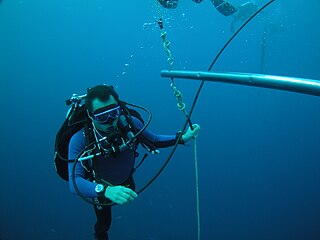
Decompression theory is the study and modelling of the transfer of the inert gas component of breathing gases from the gas in the lungs to the tissues and back during exposure to variations in ambient pressure. In the case of underwater diving and compressed air work, this mostly involves ambient pressures greater than the local surface pressure, but astronauts, high altitude mountaineers, and travellers in aircraft which are not pressurised to sea level pressure, are generally exposed to ambient pressures less than standard sea level atmospheric pressure. In all cases, the symptoms caused by decompression occur during or within a relatively short period of hours, or occasionally days, after a significant pressure reduction.
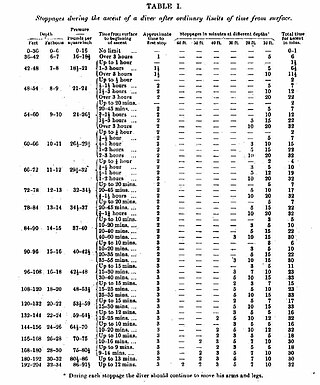
Haldane's decompression model is a mathematical model for decompression to sea level atmospheric pressure of divers breathing compressed air at ambient pressure that was proposed in 1908 by the Scottish physiologist, John Scott Haldane, who was also famous for intrepid self-experimentation.
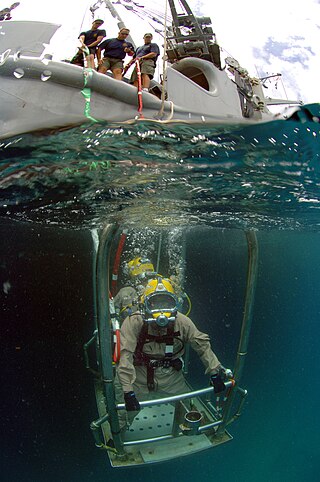
There are several categories of decompression equipment used to help divers decompress, which is the process required to allow divers to return to the surface safely after spending time underwater at higher ambient pressures.
Brian Andrew Hills, born 19 March 1934 in Cardiff, Wales, died 13 January 2006 in Brisbane, Queensland, was a physiologist who worked on decompression theory.
Inner ear decompression sickness, (IEDCS) or audiovestibular decompression sickness is a medical condition of the inner ear caused by the formation of gas bubbles in the tissues or blood vessels of the inner ear. Generally referred to as a form of decompression sickness, it can also occur at constant pressure due to inert gas counterdiffusion effects.
The US Navy has used several decompression models from which their published decompression tables and authorized diving computer algorithms have been derived. The original C&R tables used a classic multiple independent parallel compartment model based on the work of J.S.Haldane in England in the early 20th century, using a critical ratio exponential ingassing and outgassing model. Later they were modified by O.D. Yarborough and published in 1937. A version developed by Des Granges was published in 1956. Further developments by M.W. Goodman and Robert D. Workman using a critical supersaturation approach to incorporate M-values, and expressed as an algorithm suitable for programming were published in 1965, and later again a significantly different model, the VVAL 18 exponential/linear model was developed by Edward D. Thalmann, using an exponential ingassing model and a combined exponential and linear outgassing model, which was further developed by Gerth and Doolette and published in Revision 6 of the US Navy Diving Manual as the 2008 tables.
References
- 1 2 Bühlmann, Albert Alois (1984). Decompression-decompression sickness [Translation of: Dekompression-Dekompressionskrankheit]. Translated by Gilbert Paul Michel. Berlin, Heidelberg: Springer-Verlag. doi:10.1007/978-3-662-02409-6. ISBN 978-3-662-02409-6.
- 1 2 3 4 5 6 7 8 9 10 11 12 13 14 Völlm, Ernst B.; Götte, Georg (1994). "Leading diving researcher dies unexpectedly: Albert A Bühlmann, 1923 - 1994". Pressure, newsletter of the Undersea and Hyperbaric Medical Society. 23 (3): 1–3. ISSN 0889-0242.
- 1 2 Wendling, J; Nussberger, P; Schenk, B (1999). "Milestones of the deep diving research laboratory Zurich". South Pacific Underwater Medicine Society Journal. 29 (2). ISSN 0813-1988. OCLC 16986801. Archived from the original on 2012-02-03. Retrieved 2009-06-12.
{{cite journal}}: CS1 maint: unfit URL (link) - ↑ Schreiner, Heinz (1994). "Prof. Albert A Bühlmann: Maker of diving history". Pressure, newsletter of the Undersea and Hyperbaric Medical Society. 23 (3): 3. ISSN 0889-0242.
- ↑ Bühlmann, Albert A. (1973). "Ethical considerations in hyperbaric research--situation in Switzerland". Försvarsmedicin. 9 (3): 367–8. PMID 11661279.
- 1 2 3 4 Bühlmann, AA (1984). Decompression-Decompression Sickness. Berlin New York: Springer-Verlag. ISBN 0-387-13308-9.
- ↑ Powell, Mark (2008-10-18). Deco for Divers: Decompression Theory and Physiology. AquaPress. ISBN 1-905492-07-3.
- ↑ hanneskeller.com. "Hannes Keller Biography". hanneskeller.com. Archived from the original on 2011-08-17. Retrieved 2009-06-12.
- 1 2 Swann, C (2007). "Hannes Keller and His Secret Mixtures" (PDF). The History of Oil Field Diving. Chapter 8. Oceanaut Press: 105–113. Archived from the original (PDF) on 2008-11-20. Retrieved 2009-06-12.
- ↑ Boycott, A. E.; G. C. C. Damant; J. S. Haldane. (1908). "The Prevention of Compressed-air Illness". J. Hygiene. 8 (3): 342–443. doi:10.1017/S0022172400003399. PMC 2167126 . PMID 20474365. Archived from the original on 2011-03-24. Retrieved 2009-06-12.
{{cite journal}}: CS1 maint: unfit URL (link) - ↑ Workman, Robert D. (1957). "Calculation of air saturation decompression tables". Navy Experimental Diving Unit Technical Report. NEDU-RR-11-57. Archived from the original on 2011-09-18. Retrieved 2009-06-12.
{{cite journal}}: CS1 maint: unfit URL (link) - ↑ Bühlmann Albert A; Frei P; Keller Hannes (October 1967). "Saturation and desaturation with N2 and He at 4 atm". Journal of Applied Physiology. 23 (4): 458–62. doi:10.1152/jappl.1967.23.4.458. PMID 6053671 . Retrieved 2009-06-13.
- ↑ Bühlmann Albert A (1989). "[Decompression problems in diving in mountain lakes]". Schweiz Z Sportmed (in French). 37 (2): 80–3, discussion 99–102. PMID 2799365.
- ↑ Bühlmann Albert A (1984). "[Decompression during lowered air pressure]". Schweiz Med Wochenschr (in German). 114 (26): 942–7. PMID 6087447.
- ↑ Bühlmann Albert A, Schibli R, Gehring H (March 1973). "[Experimental studies on decompression following diving in mountain lakes at reduced air pressure]". Schweiz Med Wochenschr (in German). 103 (10): 378–83. PMID 4144210.
- ↑ Böni M.; Schibli R.; Nussberger P.; Bühlmann Albert A. (1976). "Diving at diminished atmospheric pressure: air decompression tables for different altitudes". Undersea Biomed Res. 3 (3): 189–204. ISSN 0093-5387. OCLC 2068005. PMID 969023. Archived from the original on July 8, 2012. Retrieved 2009-06-12.
{{cite journal}}: CS1 maint: unfit URL (link) - ↑ Bühlmann, AA (1987). "Decompression after repeated dives". Undersea Biomedical Research. 14 (1): 59–66. ISSN 0093-5387. OCLC 2068005. PMID 3810993. Archived from the original on July 7, 2012. Retrieved 2009-06-12.
{{cite journal}}: CS1 maint: unfit URL (link) - 1 2 Powell, Mark. "Decompression Theory: Robert Workman and Prof A Bühlmann". Dive-Tech. Archived from the original on 10 June 2009. Retrieved 2009-06-12.
- ↑ Bühlmann, AA (1992). Tauchmedizin: Barotrauma Gasembolie Dekompression Dekompressionskrankheit (in German). Berlin: Springer-Verlag. ISBN 3-540-55581-1.
- ↑ Bühlmann, AA (1995). Tauchmedizin (in German). Berlin: Springer-Verlag. ISBN 3-540-55581-1.